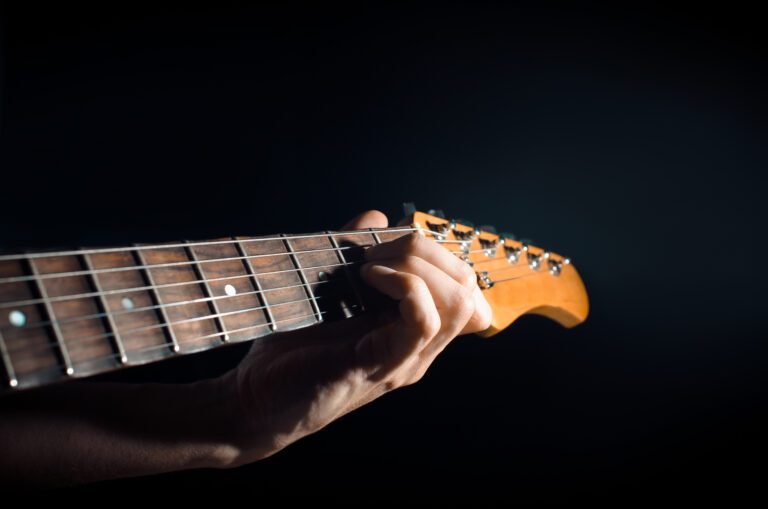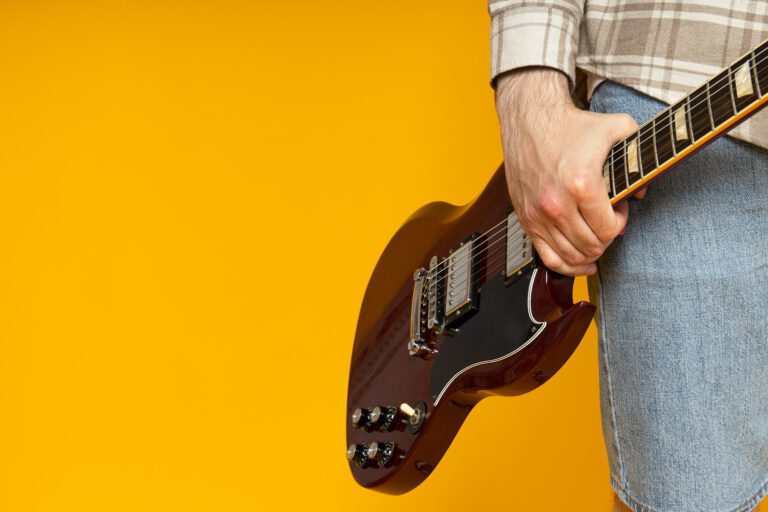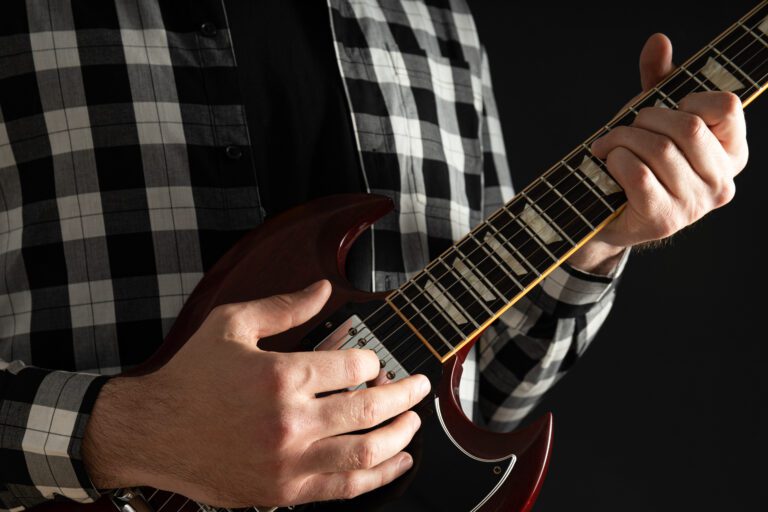How to Sound Like Your Favorite Rock Guitarist
Sound like your favorite rock guitarist—it’s a dream shared by almost every beginner. Whether you’re drawn to Slash’s fiery solos, Jimi Hendrix’s psychedelic bends, or John Mayer’s bluesy warmth, achieving that iconic tone feels magical. But great sound isn’t just about raw talent—it comes down to the right gear, tone settings, playing technique, and your overall mindset.
This guide breaks down how you can start sounding like your favorite rock guitarist, even with beginner gear. Whether you’re jamming in your bedroom or prepping for your first gig, these tips will help you shape your signature sound.
🔌 1. Understand the Building Blocks of Rock Tone

Your tone depends on:
- Guitar Type: Stratocaster, Les Paul, SG, etc.
- Pickups: Single-coil = crisp; Humbucker = thick
- Amp Settings: EQ, gain, reverb, etc.
- Pedals & Effects: Overdrive, delay, chorus, etc.
- Playing Technique: Vibrato, bends, slides, picking style
🎯 You don’t need expensive gear to start—just learn how to shape your sound with what you have.
🎸 2. Match the Gear Style (On a Budget)

- Guitar: Les Paul-style
- Tone: Warm, thick distortion
- Amp: Marshall-style
- Pedal: Wah + Overdrive
- Guitar: Fender Strat
- Tone: Bright, bluesy, raw
- Amp: Fuzz face or clean tube amp
- Pedal: Wah, Univibe, Fuzz
- Guitar: Strat-style
- Tone: Clean, bluesy with edge
- Amp: Fender-style with reverb
- Pedal: Delay, Overdrive, Clean boost
🛠️ Tip: Use modeling amps, multi-FX pedals, or amp sims on software like Tonebridge or AmpliTube to replicate tones without buying expensive gear.
⚙️ 3. Basic Amp Settings for Rock Guitar

Start with these base settings and tweak to taste:
- Gain/Drive: 6–8 (higher for heavy rock)
- Bass: 4–5
- Mid: 6–7 (boost for lead tones)
- Treble: 6–7
- Reverb: Optional, around 2–3
- Master Volume: As needed
🎛️ Experiment with your amp’s tone knobs—they’re more powerful than most beginners realize!
🎵 4. Master the Playing Style

Tone is 80% in your hands. Study how your favorite guitarist:
- Picks (fingers or pick? hard or soft?)
- Uses vibrato and bends
- Slides or hammers-on
- Controls dynamics (soft vs loud playing)
🎯 Try learning short licks or solos from your favorite songs. Record yourself and compare to the original. Tone begins where technique meets intent.
🎚️ 5. Use Effects Sparingly (But Smartly)

Common effects for rock tone:
- Overdrive/Distortion – adds bite and sustain
- Wah-Wah – expressive, vocal-like filter
- Delay – echoes your notes (for depth)
- Chorus – thickens your tone
- Fuzz – used by Hendrix for wild grit
🎸 Don’t overuse them. Start with just overdrive and delay for most rock tones.
🎧 6. Train Your Ears with Reference Tracks

- Pick 2–3 songs from your favorite guitarist
- Listen to isolated guitar tracks on YouTube
- Play along and match tone, timing, and touch
- Use slow-down tools like Moises, GuitarTabs, or YouTube’s speed tool
- Ear training is key to replicating feel and tone.
🧱 7. Build Your Signature Sound Over Time

Eventually, don’t just copy—combine influences and add your own flavor. Think of it like cooking:
- Slash’s sustain + Hendrix’s dynamics + your feel = Your Tone
- Record yourself often and adjust
- Ask teachers or mentors for feedback
📈 Your tone evolves as your playing matures.
🎓 Learn Rock Guitar with The Mystic Keys
At The Mystic Keys, we help beginners develop real musical skills—like tone control, lead guitar techniques, and rhythm essentials. Our one-on-one Zoom sessions are perfect for rock lovers who want to sound like their favorite rock guitarist—right from day one.
🎸 We offer:
Beginner & intermediate rock guitar courses
Personalized tone shaping with any gear
Trinity certification guidance
Notes, recordings & flexible scheduling
Certified Grade 8 rock guitar instructors
Whether you’re into Slash, Hendrix, Mayer—or your own mix—we’ll help you develop tone, technique, and confidence.
🧠 Final Thoughts: Tone Is a Journey
You don’t need the exact gear your idols use to start sounding like them. What matters most is:
- Understanding how tone works
- Practicing your ear and playing style
- Using your current gear creatively
- Listening and refining over time
🎶 Sounding like your favorite guitarist is great—but becoming the guitarist others want to sound like is even better.
For more information and exciting resources about learning music, visit our website at The Mystic Keys. For more music content and exciting offers follow us on
Facebook, Instagram, YouTube, LinkedIn, Twitter, Pinterest, and Threads,
Related Blogs
Music Theory Guide For Beginner’s
This Music Theory Guide is perfect for beginners who want to understand how music works—from notes and scales to chords and rhythm. It lays a strong foundation that helps musicians of all levels gain clarity and confidence in their playing, composing, or singing.
The Best Way to Train Your Ear for Music
A well-trained ear is one of the most valuable tools any musician can have. Whether you’re a singer, instrumentalist, producer, or composer, your ability to recognize pitch, rhythm, harmony, and melody will significantly enhance your creativity and confidence.
The voice is an incredible gift. It’s how we sing, teach, inspire, and connect. But like any instrument, it needs proper care to remain strong, clear, and resilient. Vocal strain is a common challenge faced not only by singers, but also by teachers, speakers, coaches, content creators—anyone who relies on their voice daily.








